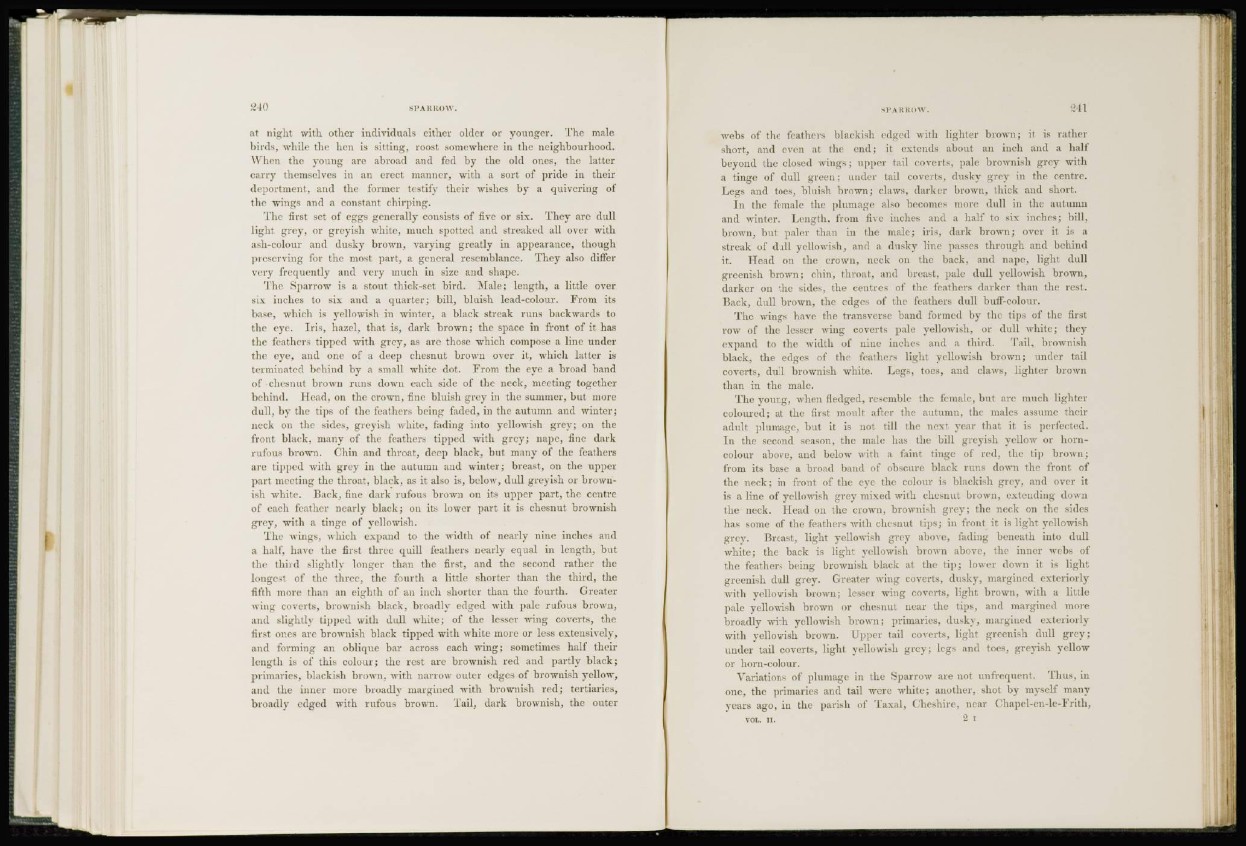
240 SPARROW.
at night with other individuals either older or younger. The male
birds, while the hen is sitting, roost somewhere in the neighbourhood.
When the young are abroad and fed by the old ones, the latter
carry themselves in an erect manner, with a sort of pride in their
deportment, and the former testify their wishes by a quivering of
the wings and a constant chirping.
The first set of eggs generally consists of five or six. They are dull
light grey, or greyish white, much spotted and streaked all over with
ash-colour and dusky brown, varying greatly in appearance, though
preserving for the most part, a general resemblance. They also differ
very frequently and very much in size and shape.
The Sparrow is a stout thick-set bird. Male; length, a little over
six inches to six and a quarter; bill, bluish lead-colour. From its
base, which is yellowish in winter, a black streak runs backwards to
the eye. Iris, hazel, that is, dark brown; the space in front of it has
the feathers tipped with grey, as arc those which compose a line under
the eye, and one of a deep chesnut brown over it, which latter is
terminated behind by a small white dot. From the eye a broad band
of chesnut brown runs down each side of the neck, meeting together
behind. Head, on the crown, fine bluish grey in the summer, but more
dull, by the tips of the feathers being faded, in the autumn and winter;
neck on the sides, greyish white, fading into yellowish grey; on the
front black, many of the feathers tipped with grey; nape, fine dark
rufous brown. Chin and throat, deep black, but many of the feathers
arc tipped with grey in the autumn and winter; breast, on the upper
part meeting the throat, black, as it also is, below, dull greyish or brownish
white. Back, fine dark rufous brown on its upper part, the centre
of each feather nearly black; on its lower part it is chesnut brownish
grey, with a tinge of yellowish.
The wings, which expand to the width of nearly nine inches and
a half, have the first three quill feathers nearly equal in length, but
the third slightly longer than the first, and the second rather the
longest of the three, the fourth a little shorter than the third, the
fifth more than an eighth of an inch shorter than the fourth. Greater
wing coverts, brownish black, broadly edged with pale rufous browm,
and slightly tipped with dull white; of the lesser wing coverts, the
first ones are brownish black tipped with white more or less extensively,
and forming an oblique bar across each wing; sometimes half their
length is of this colour; the rest arc brownish red and partly black;
primaries, blackish brown, with narrow outer edges of brownish yellow,
and the inner more broadly margined with brownish red; tertiaries,
broadly edged with rufous brown. Tail, dark brownish, the outer
webs of the feathers blackish edged with lighter brown; it is rather
short, and even at the end; it extends about an inch and a half
beyond the closed wings; upper tail coverts, pale brownish grey with
a tinge of dull green; under tail coverts, dusky grey in the centre.
Legs and toes, bluish brown; claws, darker brown, thick and short.
In the female the plumage also becomes more dull in the autumn
and winter. Length, from five inches and a half to six inches; bill,
brown, but paler than in the male; iris, dark brown; over it is a
streak of dull yellowish, and a dusky line passes through and behind
it. Head on the crown, neck on the back, and nape, light dull
greenish brown; chin, throat, and breast, pale dull yellowish brown,
darker on the sides, the centres of' the feathers darker than the rest.
Back, dull brown, the edges of the feathers dull buff-colour.
The wings have the transverse band formed by the tips of the first
row of the lesser wing coverts pale yellowish, or dull white; they
expand to the width of nine inches and a third. Tail, brownish
black, the edges of the feathers light yellowish brown; under tail
coverts, dull brownish white. Legs, toes, and claws, lighter brown
than in the male.
The young, when fledged, resemble the female, but are much lighter
coloured; at the f i r s t moult after the autumn, the males assume their
adult plumage, but it is not till the next year that it is perfected.
In the second season, the male has the bill greyish yellow or horncolour
above, and below with a faint tinge of red, the tip brown;
from its base a broad band of obscure black runs down the front of
the neck; in front of the eye the colour is blackish grey, and over it
is a line of yellowish grey mixed with chesnut brown, extending down
the neck. Head on the crown, brownish grey; the neck on the sides
has some of the feathers with chesnut tips; in front it is light yellowish
grey. Breast, light yellowish grey above, fading beneath into dull
white; the back is light yellowish brown above, the inner webs of
the feathers being brownish black at the tip; lower down it is light
greenish dull grey. Greater wing coverts, dusky, margined exteriorly
with yellowish brown; lesser wing coverts, light brown, with a little
pale yellowish brown or chesnut near the tips, and margined more
broadly with yellowish brown; primaries, dusky, margined exteriorly
with yellowish brown. Upper tail coverts, light greenish dull grey;
under tail coverts, light yellowish grey; legs and toes, greyish yellow
or horn-colour.
Variations of plumage in the Sparrow are not unfrequcnt. Thus, in
one, the primaries and tail were white; another, shot by myself many
years ago, in the parish of Taxal, Cheshire, near Chapel-cn-lc-Frith,
VOL. it. 2 i